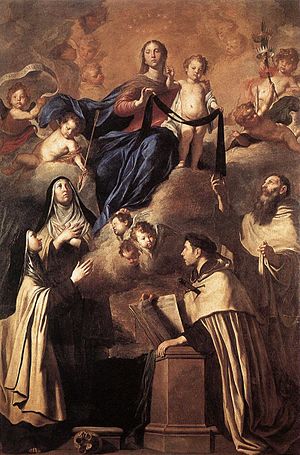 Image via Wikipedia( I'm sharing a great article about the Brown Scapular of our Lady of Mount Carmel , written by Father Kieran Kavanaugh, OCD)
Image via Wikipedia( I'm sharing a great article about the Brown Scapular of our Lady of Mount Carmel , written by Father Kieran Kavanaugh, OCD) During the Crusades in 12th century, a group of Westerners took up the lifeof hermits by the well of St. Elijah on Mt. Carmel. They built a chapel in honor of the Mother of Jesus, conscious that they were living in the area made holy by Jesus and his Mother (Nazareth is less than 20 miles away).
When Saracens toppled the Latin kingdom of the Crusaders, the hermits of Carmel had to flee the holy mountain and return to the West -- to Cypress ,Sicily, France, England, Ireland and other countries. They brought with them little more than their title of "Brothers of the Blessed Virgin Mary of Mount Carmel."
In Europe they were entering a hostile world cluttered with many new religious families. The arrival of strangers from Mount Carmel was inauspicious, they were frowned upon. Internally, they were divided as towhether they should cling to their background as hermits or adapt to a newstatus of begging friars.
According to tradition, as an important fact in the midst of these difficulties, Our Lady of Mount Carmel appeared to the prior general, St.Simon Stock, at Aylesford, England. According to tradition, Our Ladyappeared on July 16, 1251.
The Blessed Virgin promised St. Simon Stock, oppressed with worries, that whoever would wear the Carmelite habit devoutly would receive the gift offinal perseverance. The habit was taken to mean the scapular in particular.
The scapular was a broad band of cloth over the shoulders, falling below the knees toward the feet front and back as an apron, worn still as part of the religious habit by a number of orders of monks and friars. As it was gradually adapted for use by the laity, it became two small panels of brown cloth joined by strings and worn over the shoulders as a familiar Marian sacramental.
From the 16th century until the Second Vatican Council the scapular received warm welcome from the faithful and enjoyed a singular approval by the Church magisterium. Part of the reason for this esteem was undoubtedly the constant stream of wonderful graces, spiritual and temporal, that were poured out on individuals through its devout use.
But another reason for its popularity was its strict connection with the last things, with the salvation of our soul, which takes priority over all our other duties here below.
Crisis
After the Second Council, the scapular devotion suffered the same "crisis of rejection" that so many other practices and teachings within the Catholic Church.
First, it was said that St. Simon Stock never even existed. As a consequence, his feast day, which had been celebrated on May 16, the date of his death, was expunged from the liturgical calendar.
Second, if he never existed, then we must do away with the feast of Our Lady of Mt. Carmel and the scapular devotion. The effort was then made by a liturgical committee to expunge Our Lady of Mount Carmel from the liturgical calendar, but the Latin American bishops protested so vehemently that the feast was kept; however, on condition that nothing be mentioned about the scapular.
One of the internationally renowned Mariologists of our order, Father Nilo Geagea from Lebanon then set about doing a very thorough research into the whole history of devotion to Mary in our order.
The result of his years of study is a huge wonderfully researched and documented volume published by the Teresian Historical Institute in 1988; soit is a fairly recent study. The title of the book is "Maria Madre e Decorodel Carmelo."
Through painstaking demonstration, Father Nilo shows how even the most intransigent critic could not put into reasonable doubt the historical existence of St. Simon Stock. St. Simon Stock's feast day was, in fact,restored by the Congregation for Divine Worship and the Sacraments in 1979.







No comments:
Post a Comment